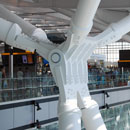Innovative Connections
Cast Connections
Cast connections are actually about simplicity. Cast connections are being used increasingly in projects. The characteristics of today's steel castings have nothing to do with its earlier cousin: cast iron. Casting was formerly used to create highly ornate, repetitive structures, that were not possible by rolling or extruding the steel. Cast iron was not able to be welded as it had a high carbon content and was very brittle.
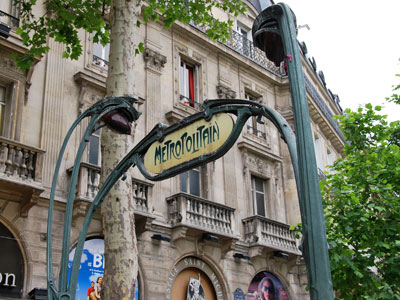 |
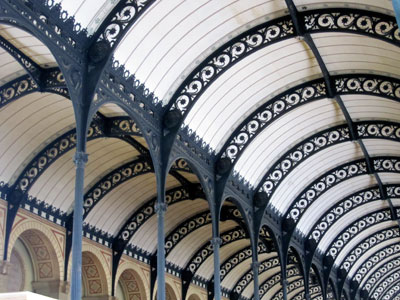 |
The Paris Metro entrances by Hector Guimard took advantage of the casting process to create highly ornate design. |
The Biblioteque Ste. Genevieve by Henri Labrouste used cast steel to economically replicate identical, ornage, elements. |
Steel castings today are higher strength, weldable and more ductile. You generally see castings in conjunction with cable and glass structures, or in complex tubular joints for buildings or bridges. While they bring with them the added advantage of handling complex, curved geometries without the difficulties found using multiple combinations of tubes and plates, they do require a different level of engineering and testing expertise.
Economy is still found in the mass production of the elements. One-off castings or small runs can be very expensive.Hence, for castings to work, you need a reason.
• Do you have repetition (so the cost of making the mould is partly amortized)? (A must) Are there many elements coming to one point?
• Do you want to use castings in a high-stress zone?
• Do you have a foundry in your area that has the expertise?
• Would castings provide aesthetic advantages?
If you answer yes to at least 3 of these questions, then maybe these are appropriate for your project. A rough `rule of thumb' is that if the connection starts to cost four times as much as the material it is made of, then steel castings start to be economical.
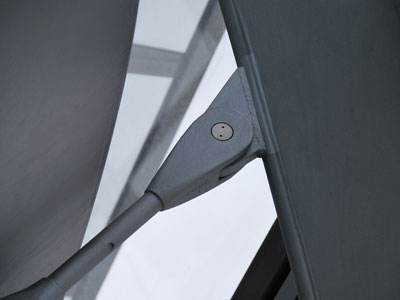 |
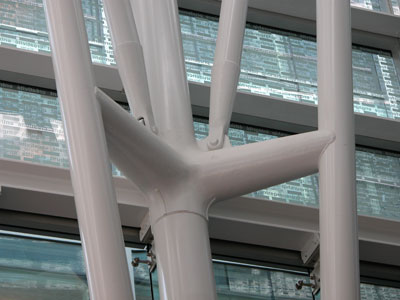 |
Smaller castings are generally die cast and can be produced in larger runs. There is better economy. This solid steel pin connector, technically called a clevis, is part of the Reichstag in Berlin by Foster+Partners. You can see an identifiable connection between the rod and the casting. There has been no extra effort/expense to conceal the meeting of the two elements. This type of pin connector will normally use a specialty connector rather than a simple bolt. |
This casting at the Caisse du Depots et Placements in Montreal, Quebec is and example of a larger, sand or resin cast, hollow cast connector. There was some repetition of elements within the large atrium space, but the casting process for these large elements normally involves limited use of the cast. Smaller hollow castings have been used as the end/pin type connectors for the upper web members of this vertical truss. Again the connection between the HSS members and the casting is not concealed. |
A cast member has a different finish. This is due to their manufacturing process and a function of the material that creates the form for the casting. For example if a sand casting is used the surface texture of the finished steel will have a rough sand like appearance. Special finishing will be required if a seamless final appearance is sought between the casting and the adjacent tubular member. For higher levels of AESS categories, this can mean significant grinding and filling to smooth out the rougher finish of the casting, or remove casting mill marks.
Castings can be formed hollow or solid. Solid castings are usually to be found in smaller connectors like the ones that are used to form the terminus of tension rod type structures. Hollow castings are used for larger members as solid castings would have difficulty in achieving uniform cooling and would be more expensive. Non uniform cooling can create internal stresses. Non-destructive evaluation of each casting, including 100% ultrasonic testing should be considered as a minimum. When selecting a caster be sure that they will perform appropriate testing.
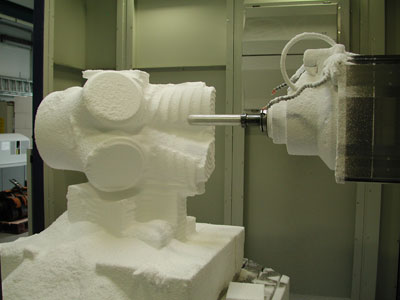 |
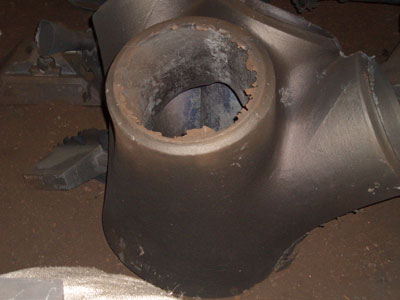 |
Larger castings are made from expendible moulds. The base shape is translated from the CAD file, into 3D. A resin cast is made from this full sized 3D element. |
The casting must be cleaned up after it is removed from the resin mould. You can see the granular surface of the casting as a result of the sand cast method. If this is not acceptable, then it will cost extra to have the fabricator grind and fill the surface. |
Large specialty castings require specific testing to ensure that they are properly designed and capable of resisting stresses. Cast steel exhibits isotropic properties, making it quite suitable for transferring forces through the connections in a reliable manner—i.e., being able to resist shear, moment, and torsional stresses. It accomplishes this by working the geometry as a function of variations in the wall thickness, independently of the finished form of the exterior. Unlike fabrications made from tubes or plates, the interior dimensions of the void in a casting do not have to match the exterior form of the object.
CAST CONNECTIONS CAN BE SMALL AND FAIRLY REPETITIVE...
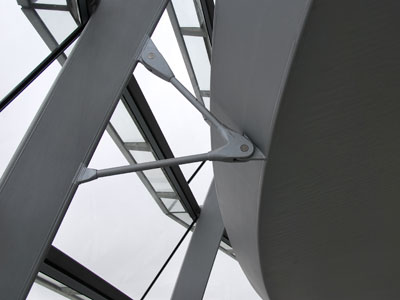 |
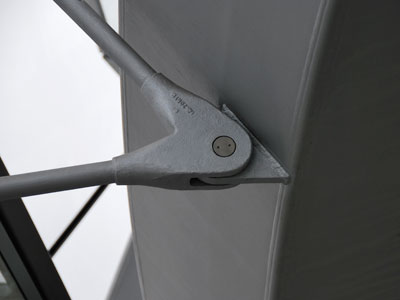 |
Castings are used to connect parts of the Reichstag walkway system as they can give a very clean appearance and there is also much repetition to warrant making special die casts. A custom fabricated steel element would have been clunky in appearance. |
The designers have modified the typical end connector to allow for the attachement of two rods. This begins to generate a "family of connections" to work with the overall design. A simple rounded triangular plate is used to attach the connector to the steel ramp. |
CAST CONNECTIONS CAN BE LARGE AND FAIRLY UNIQUE....
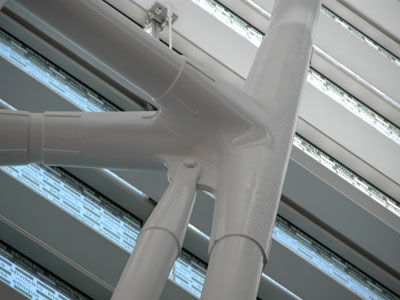 |
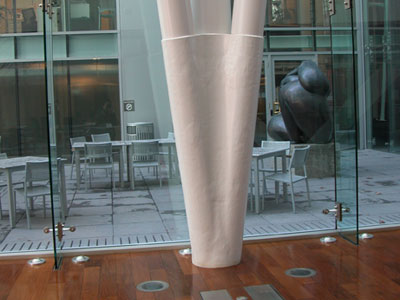 |
The Caise du Depots et Placement in Montreal makes use of a variety of large hollow castings to create its architectural connection language. Each is a slight variation of the other. These are designed to accept hollow structural sections. The connection points are welded. Where other members are to be connected on site, pin type connections allow for easier on site bolting. |
The base connecton for the vertical trusses uses a casting in order to bring the three vertical HSS members together. The V shaped base more cleanly allows for the three round members to converge at one point. The texture of the base casting reveals its fabrication process. |
CASTINGS CAN BE CONNECTED WITH A SEAMLESS APPEARANCE...
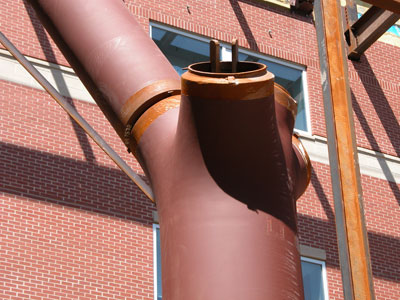 |
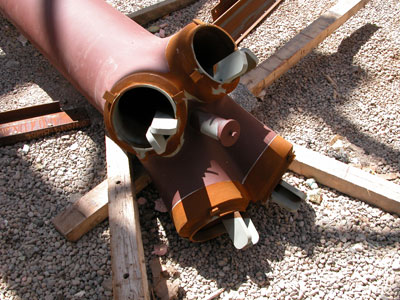 |
The mechanical pipe that is connected to this cast node at the University of Guelph Science Building is precisely the same diameter as the node portion. The members will be welded together and the welds ground and filled as to be invisible. This was done to attach the node to the trunk of the tree in the shop where such work is easier to do. |
A closer view of one of the smaller nodes. You can see the smaller tube that is set inside the node to backstop the weld. The primer has been held back from the portion to be welded. The corrosion will be removed prior to welding. The white tabs sticking out are used to align and hold the upper branches in position until they can be welded and fixed into place. |
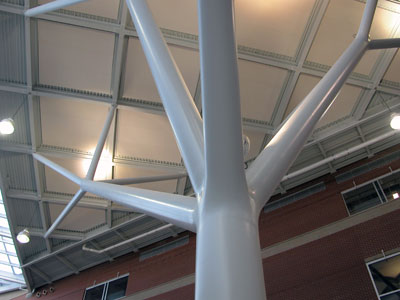 |
|
The weld seam that joins the branch to the casting requires multiple passes and subsequent grinding and filling in order to create the seamless appearance desired by the architect. |
It was extremely important to take into consideration the high gloss paint finish as it would be completely unforgiving and reveal any minute imperfection in the fabrication. |
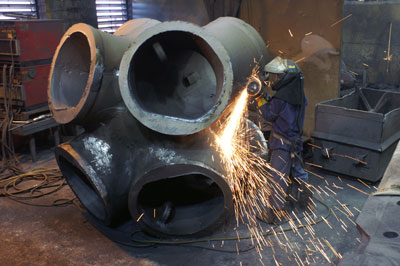 |
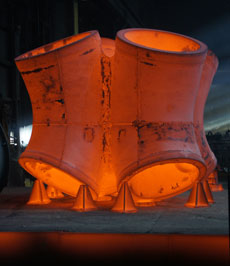 |
The node elements for the Queen Richmond Centre in Toronto will be formed by these large castings. You can see the scale of the incoming round tubular column elements. Castings by CastConnex®. |
A view of the casting when it is still red hot. The cooling must be carefully controlled as not to result in internal stresses that could cause a failure. |
Seismic uses for castings. Solid castings are being effectively used in seismic installations.
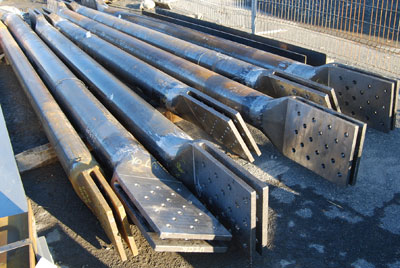 |
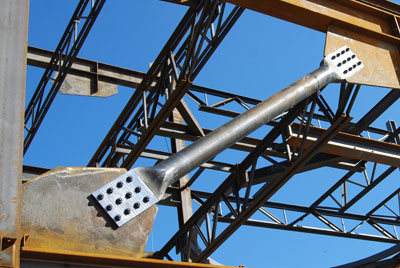 |
These high strength cast seismic connectors, developed by CastConnex®, can be used as the diagonal bracing in seismic resistant concentrically framed steel buildings. The casting is welded to a hollow structural member. |
The diagonal braces are able to absorb the seismic forces and are simpler to erect than some alternate systems. These castings were donated to Haiti for their earthquake recovery! http://www.dailycommercialnews.com/article/id53527/ |
